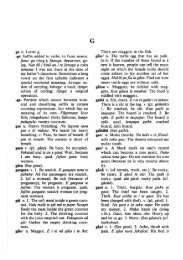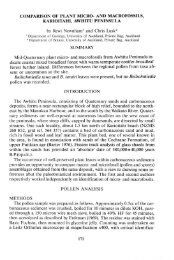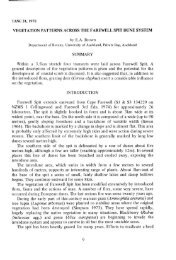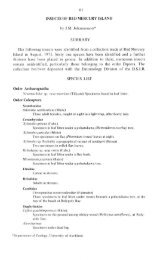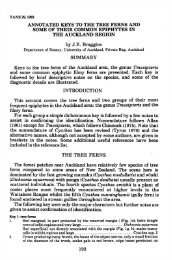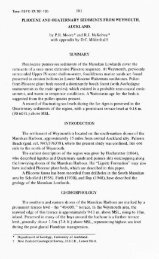aspects of fish biology form and function
aspects of fish biology form and function
aspects of fish biology form and function
You also want an ePaper? Increase the reach of your titles
YUMPU automatically turns print PDFs into web optimized ePapers that Google loves.
295a<br />
the actual locomotor organs they <strong>function</strong> to stabilise <strong>and</strong> manoeuveur the<br />
<strong>fish</strong>. The median fins (dorsal <strong>and</strong> anal) prevent rolling <strong>and</strong> yawing in<br />
the vertical axis while the paired fins (pectoral <strong>and</strong> ventral) prevent<br />
the <strong>fish</strong> pitching horizontally. Turning is achieved chiefly by the<br />
pectoral <strong>and</strong> ventral fins with body movements also playing some part. The<br />
pectoral fins are nearly always used for braking; however, some <strong>fish</strong><br />
simply reverse their primary locomotory apparatus, e.g. the leather-<br />
jacket (Parika scaber) reverses the direction <strong>of</strong> the undulations <strong>of</strong> the<br />
dorsal <strong>and</strong> anal fins.<br />
For most <strong>fish</strong> the shape <strong>and</strong> size <strong>of</strong> the pectoral fins, especially<br />
the caudal fin, is a good index <strong>of</strong> speed, agility <strong>and</strong> mode <strong>of</strong> life<br />
(figure 5). Fish with large square-cut or rounded tail fins as seen in<br />
most reef <strong>fish</strong> are usually comparatively slow swimmers, but are capable<br />
<strong>of</strong> sudden bursts <strong>of</strong> speed. A deeply forked <strong>and</strong> lunate tail, a narrow<br />
caudal peduncle <strong>and</strong> small sickle-shaped pectoral fins are typical <strong>of</strong> the<br />
fast-swimming pelagic <strong>fish</strong>es, e.g. the carangids, the tuna <strong>and</strong>. mackerel<br />
<strong>and</strong> the snoek (Thrysites atun) . The midwater planktivorous <strong>fish</strong> (e.g.<br />
two-spot demoiselles, Chromis dispilus <strong>and</strong> butterfly perch, Caesioperca<br />
lepidoptera) have deeply forked tails <strong>and</strong> long oval pectoral fins,<br />
allowing great manoeuverability. Hole dwelling <strong>and</strong> weed dwelling <strong>fish</strong><br />
such as the eels <strong>and</strong> syngnathids (seahorses <strong>and</strong> pipe<strong>fish</strong>) have the<br />
caudal <strong>and</strong> pectoral fins reduced in size <strong>and</strong> efficiency, <strong>and</strong> consequently<br />
are poor swimmers. These <strong>fish</strong> also usually lack pelvic fins.<br />
Fins also serve <strong>function</strong>s other than locomotion <strong>and</strong> may be<br />
modified accordingly (figure 5). The dorsal <strong>and</strong> anal fins are capable<br />
<strong>of</strong> being erected or depressed <strong>and</strong> are frequently used during aggressive<br />
or courting displays. The spines <strong>and</strong> rays arfe supplied with muscles for<br />
this purpose. The spines also provide the <strong>fish</strong> with some protection<br />
against predators. These fins <strong>of</strong>ten also complement a <strong>fish</strong>' s camouflage.<br />
For example, the long trailing fins <strong>of</strong> the butter<strong>fish</strong> (Odax pullus) <strong>and</strong><br />
the crested weed<strong>fish</strong> (Cristiceps aurantiacus) resemble"the weed in which<br />
the <strong>fish</strong> live.<br />
Many modifications are associated with seeking <strong>and</strong> obtaining food.<br />
The lower rays <strong>of</strong> the pectoral fins can be drawn out <strong>and</strong> may <strong>form</strong> long<br />
finger-like projections which act as tactile or sensory organs for<br />
detecting food, e.g. red gurnard [Chelodonichthys kumu) <strong>and</strong> porae<br />
[Chelodactylus douglasi). The first spine <strong>of</strong> the dorsal fin is greatly<br />
extended in the angler<strong>fish</strong> (Lophi<strong>form</strong>es) to <strong>form</strong> a 'line <strong>and</strong> bait 1



